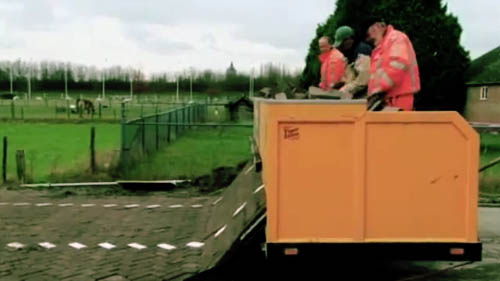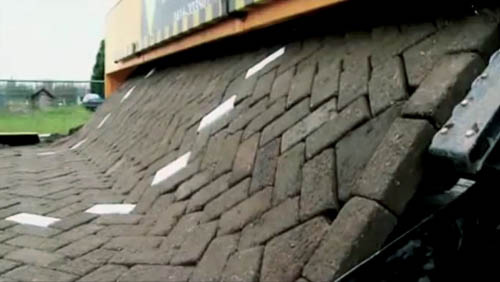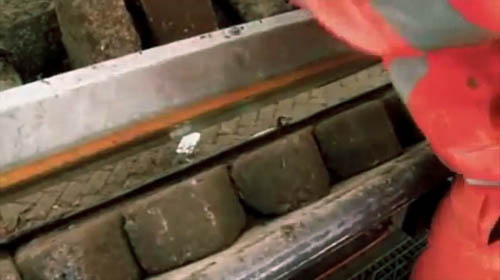A few hours ago, we looked at the exoatmospheric potential of 3D printers in space, but what about road-printers here on our own home planet, printing brick & cobblestone streets through rural villages?



 [Image: From the video, which appears below, showing the laying of so-called Tiger Stone].
[Image: From the video, which appears below, showing the laying of so-called Tiger Stone].
As it happens, a new street-printing device—unfurling a geological substrate known as Tiger Stone, as orderly and as easy “as laying laminate flooring”—can neatly place brick roads where there weren’t roads before.
Here’s a video of the “printer” in action:
After you’ve watched this footage, of course, it becomes immediately clear that it is inaccurate to refer to this technology as a literal or genuine act of “printing,” but it’s nonetheless provocative to imagine a world where roads can be created, as if from an inkjet printer, directly from the vehicles that travel on them.
In China Miéville’s book Iron Council, readers follow the path of a vehicle called the “Perpetual Train.” It operates by laying its own tracks as it moves forward, hauling in the road it travels upon only to unfurl it again seconds later, tank-like, pushing deeper into landscapes that would once have been impenetrable. It is a route that drives itself, moving, as Miéville writes, on “downlaid and uptaken rails,” whereby “the roadbed is extended, the tracks laid through, taken up again,” always cycling, again and again forward, on “rails, newly renewed,” their own context, “meandering.”
The road-printing vehicle featured in the video above clearly presents no such utopia, but it does offer at least a domesticated variant on Miéville’s mobile perpetuity, bringing roads to distant towns in a single afternoon. What is the geographical status of the road that, itself, can travel?
(Thanks to Jon Bucholtz for the tip!)

Geoff —
Have you ever heard of a Track Re-Laying Train? It lays railroad track by lifting the rails, munching up the ties, and laying new ties behind it. It can do 1000ft/hr. A similar, though less comprehensive, concept.
Jay, I'll look into it – sounds cool.
Hi Geoff,
It's likely that you may have seen this before, but your post reminds me of the visionary Disney animation, Magic Highway:
Simon, I had never seen that, either. Thanks!
And I believe Band-Aid are bring out their pothole range of plasters soon too 😉
Although the idea of Miéville's book is beautiful and metaphoric, it is also a little comedic, because essentially as you mentioned, the torn up rails would have to be consistently brought to the front of the train to be laid down again. Essentially it's an overcomplicated tank tread, when really, a simple circle – a wheel, with some all-terrain tread lets say – would have done the same. Love the idea of printing roads from scratch though. I think what interests me the most is the possibilities of interventions if someone other than the city had their hands on the technology.
Anonymous-
If I remember correctly, the train originally was used by exploitative corporations in areas of his world yet fully explored, to transport resources, etc. The peoples enslaved by the corporation revolt and take the train on this endless meander. I also think I remember the train's workers also doing the heavy lifting of the rail movement, not the train itself. But it's been a few years since I read it. It's probably Mieville's most overtly socialistic novel – the train's allegory was more important to the narrative than the nitty-gritty logistics.
Tom Swift and the Repelatron Skyway. My favorite.
Does this road have bike lines on either side, or are those shoulders?
For the "never ending train track", I did not know of Mieville, but I would point you to the (much anterior) book "The inverted World" of Christopher Priest.